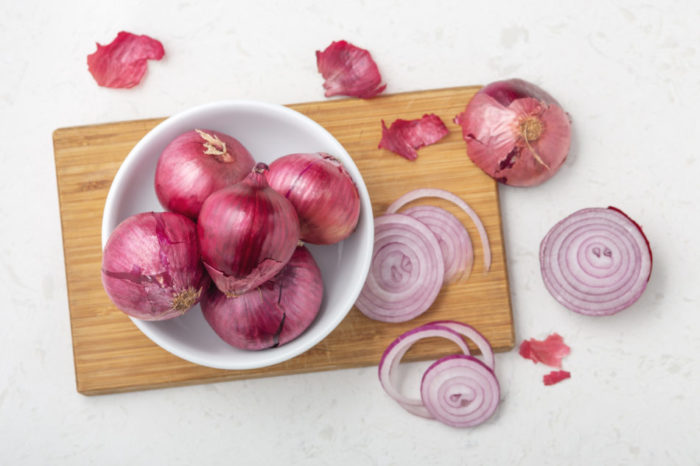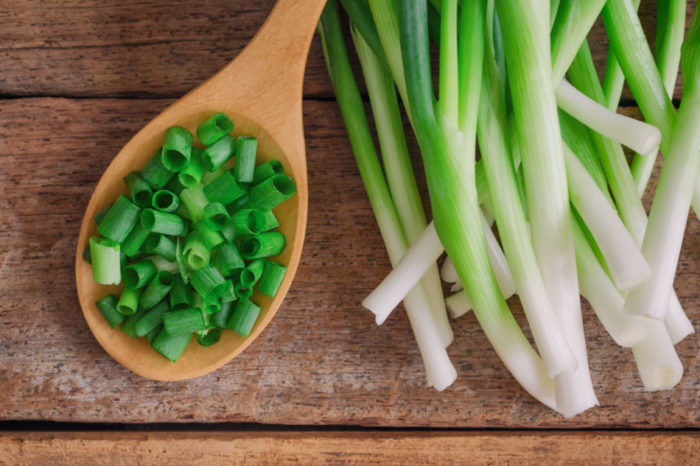There’s so much in common in scallions vs shallots comparison that one can forget that these are different food items. These foods are visibly different and have different tastes, even if they come from the same plant family.
Both these foods have points of overlap and points of difference. So let’s see what the differences are, the common misconceptions, and more on these two very similar food items.
Scallions vs Shallots – The Differences And Explanation
The Appearance And Plants Are Different
Shallots are a variety or a cultivar of onion. In some parts of the world, they’re simply called small onions. The scientific world considered them a separate species of plant for a while, though after 2010, they’re considered the same species as the common onion. In that sense, shallots are pretty much the same as onions, though smaller.

Scallions are also a part of the onion family and are sometimes known as green onions and spring onions. The plants have a leafy green stalk and a small white bulb that hasn’t matured into an onion. It is the leaves that are the characteristic feature here, not the bulb.
Scallion leaves have a fresh, grassy, onion flavor that’s the key part of these plants – the bulb is not as important. Shallots are essentially the bulb of the plant and the leaves don’t play a role here.

Taste And Flavor Factors
As we’ve established, scallions are the full plant, with the leafy greens being the key part and the small white bulb, though important, isn’t the essential part here. As such, the flavor and taste here are different as compared to shallots.
While scallions have an oniony flavor, it’s a lot milder than shallots. The leaves bring a green color to the food and a grassy taste that becomes the hallmark of scallions.
Shallots have a stronger onion flavor, though not as strong as the common onion. Their flavor is something of an onion-garlic flavor. There are some notes of sweetness here, though they’re highlighted as the shallot gets caramelized.
Shallots are an incredibly versatile food and find their way into several recipes, dishes, and cuisines. Though scallions find plenty of uses in cuisine, their use and versatility is nowhere near that of shallots.
What Are Shallots?
As we know, shallots are a cultivar of onion and take a very similar appearance to the common onion. However, they have a smaller size. For a while, they were considered a distinct plant species, but are now classified as the same species as the common onion.
Shallots grow in clusters and take on the form of smaller, more tapered onions. Much like the onion, shallots have a brown or copper color outer skin that peels off easily. Beyond this are layers of more fleshy skin. Interestingly, the layers of a shallot are arranged like cloves (as in garlic) rather than as rings (as in onions).
Though shallots have a somewhat different flavor compared to onions, many cuisines don’t explicitly separate their uses. Often, they’re simply used interchangeably as the common onion.
Generally, shallots are seen as a healthy food with low fats, low carbs, and an excellent mineral profile. They offer a good amount of proteins, fiber, calcium, iron, magnesium, phosphorus, potassium, zinc, Vitamin C, and folate.
What Are Scallions?
Scallions are often characterized as simply being green, unripe onions. They’re harvested when the onion bulb is immature and therefore, have different characteristics. Scallions represent the full plant, including the bulb and the leafy greens. In contrast, onions and shallots only represent the bulb.
While there is some truth to scallions being immature onion plants, that’s not always the case. In fact, many scallion varieties will never have a mature bulb. Many scallion varieties are specifically bred to produce vibrant leafy greens and a long white shank. After all, the leaves and shank are the prized parts of the scallion.
Such cultivars are also likely to have more tender leaves and better highlighted flavors. Of course, you could still get scallions as immature onion plants, but modern agriculture includes several scallion cultivars that don’t produce a mature bulb.
Like onions and shallots, scallions too are fairly rich in nutrients. They include a fair amount of vitamin C, vitamins B1, B2, B3, vitamin K, and other nutrients and minerals like calcium, potassium, and iron.
FAQ
What Is The Best Shallot Substitute?
Ideally, we’ll want a shallot substitute to have a similar flavor and texture as the shallot. Its ability to caramelize and have sweet notes is also useful. It’s no surprise that the best substitutes for shallots are other onion varieties. The yellow onion is usually seen as the best pick since it has a milder flavor than red or white onions and isn’t as sweet as other onions.
Of course, there are other options to use as well. The top shallot substitutes are:
- Yellow onion
- Garlic
- Chives
- Leeks
- Red onion
- Dried onions
- Scallions
Are Shallots Green Onions?
Shallots and green onions are sometimes mistakenly labeled as the same. However, both of these are very different foods with different appearances, taste, and texture.
Green onions are harvested before the onion bulb matures. At this point, the bulb is usually white and it has lush and long green leaves.
Shallots are a variety of onions where the bulb has ripened. The bulb usually has a red, brown, or copper skin and the leaves are no longer an important part of the plant. For shallots, it’s usually just the ripe bulb that’s used and the leaves (if any) are discarded with the harvest.
How To Store Scallions?
Scallions are green and leafy, so they need careful storage to make them last longer.
The easiest way is to put them in a sturdy jar that’s tall enough to hold the leaves without having them flop over. Add some water to this jar, which is just enough to cover the bulb. Place the jar on a windowsill or where there’s some sunlight, though direct sunlight is best avoided. This setup will keep the scallions fresh for a few days, while also allowing them to grow.
Another good way is to wrap the scallions in a damp paper towel and place them inside a jar or a plastic bag. Next, put this jar or bag inside the refrigerator. The damp towel/tissue will keep them humid and fresh, while the low temperature of the refrigerator helps them last longer. Note, the paper towel should be damp, not soaking wet. The latter can cause the scallions to degrade or rot.
Can You Freeze Scallions?
It is possible to freeze scallions, but keep in mind, the texture is likely to undergo some change after freezing. Usually, you’ll find the stem and bulb turning soft while the leaves get a bit harder after freezing.
The best way to go about this process is to thoroughly clean and slice the scallions before freezing. Once sliced, they’re easier to freeze as well as to thaw. Place the sliced scallions in a single row on a parchment paper-lined tray and put the tray in the freezer.
Wait until the scallions freeze, this should take about 2 hours. Remove the frozen scallions from the tray and transfer them to freezer bags. You might want to put the scallion greens and whites into separate bags, though it isn’t always necessary.
Once ready, put the freezer bags back into the freezer. The frozen scallions should stay good for about 5-6 months.
How To Mince Shallots?
To mince shallots, cut off both ends and then cut the shallot vertically. Cut each part of the shallot into chunks then place them on the cutting board. Hold the knife steady and move it in a rocking motion. Slowly and firmly put the shallots through the knife to get them finely chopped and minced.
Is A Shallot An Onion?
Shallot is the same species of onion, though a different cultivar. As such, it has some differences from the common onion, but it is acceptable to consider a shallot the same as an onion.
How To Chop Shallots?
To chop a shallot, use a paring knife to cut off the stem-end. Many people prefer to cut it from both ends, which works pretty well. After this, peel the outer layer of the shallot. This is usually easier to do by hand, though you may choose to use the knife as well.
Once you’re done peeling, cut the shallot in half vertically. Follow this by making vertical cuts on each piece towards the root end. As the next step, cut the shallot horizontally. The distance you cover between each cut defines how finely chopped the shallot will be.
Conclusion
Though they’re often confused to be the same, we can see that the similarities of Scallions VS Shallots are more about mislabeling. They can come from the same plant, though it’s not always true. Additionally, both these foods are very different in appearance, taste, texture, and even their culinary uses.